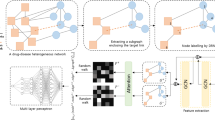Abstract
Automated drug repositioning can find potential drugs accurately and reduce R&D costs. To implement a drug repositioning system, first, the author builds a heterogeneous information network of drugs, diseases, and other types of nodes based on the heterogeneous network theory. Second, the meta-path model is introduced, and node and network topology information is learned by deep learning methods. And the interpretability of the model is improved by the attention mechanism. Experimental results on public data sets show that this method has reached state-of-the-art performance, and visual interpretability analysis of one of the inference cases is carried out. At the end of the article, the author provides the potential drugs for Alzheimer’s disease inferred from the model and cites relevant literature to prove its effectiveness.
Access this chapter
Tax calculation will be finalised at checkout
Purchases are for personal use only
Similar content being viewed by others
References
Paul, S.M., et al.: How to improve R&D productivity: the pharmaceutical industry’s grand challenge. Nat. Rev. Drug Discov. 9, 203–214 (2010)
Li, J., Zheng, S., Chen, B., Butte, A.J., Swamidass, S.J., Lu, Z.: A survey of current trends in computational drug repositioning. Brief. Bioinform. 17, 2–12 (2016)
Gottlieb, A., Stein, G.Y., Ruppin, E., Sharan, R.: PREDICT: a method for inferring novel drug indications with application to personalized medicine. Mol. Syst. Biol. 7, 496 (2011). https://doi.org/10.1038/msb.2011.26
Zeng, X., Zhu, S., Liu, X., Zhou, Y., Nussinov, R., Cheng, F.: deepDR: a network-based deep learning approach to in silico drug repositioning. Bioinform. 35, 5191–5198 (2019). https://doi.org/10.1093/bioinformatics/btz418
Liu, H., et al.: Drug repositioning for SARS-CoV-2 based on graph neural network. In: 2020 IEEE International Conference on Bioinformatics and Biomedicine (BIBM), pp. 319–322 (2020). https://doi.org/10.1109/BIBM49941.2020.9313236
Fan, S., et al.: Metapath-guided heterogeneous graph neural network for intent recommendation. In: Proceedings of the 25th ACM SIGKDD International Conference on Knowledge Discovery & Data Mining, pp. 2478–2486 (2019)
Luo, W., et al.: Dynamic heterogeneous graph neural network for real-time event prediction. In: Proceedings of the 26th ACM SIGKDD International Conference on Knowledge Discovery & Data Mining, pp. 3213–3223 (2020)
Sun, Y., Han, J., Yan, X., Yu, P.S., Wu, T.: Pathsim: meta path-based top-k similarity search in heterogeneous information networks. Proc. VLDB Endow. 4, 992–1003 (2011)
Jin, J., et al.: An efficient neighborhood-based interaction model for recommendation on heterogeneous graph. In: Proceedings of the 26th ACM SIGKDD International Conference on Knowledge Discovery & Data Mining, pp. 75–84 (2020)
Wishart, D.S., et al.: DrugBank 5.0: a major update to the DrugBank database for 2018. Nucleic Acids Res. 46, D1074–D1082 (2018)
Brown, A.S., Patel, C.J.: A standard database for drug repositioning. Sci. Data 4, 1–7 (2017)
Luo, Y., et al.: A network integration approach for drug-target interaction prediction and computational drug repositioning from heterogeneous information. Nat. Commun. 8, 1–13 (2017)
Gönen, M., Khan, S., Kaski, S.: Kernelized Bayesian matrix factorization. In: International Conference on Machine Learning, pp. 864–872. PMLR (2013)
Cortes, C., Vapnik, V.: Support-vector networks. Mach. Learn. 20, 273–297 (1995)
Heinrich-Heine University, Duesseldorf: Early Oral Switch Therapy in Low-risk Staphylococcus Aureus Bloodstream Infection. Clinicaltrials.gov (2020)
Weis, S., et al.: Cefazolin versus anti-staphylococcal penicillins for the treatment of patients with Staphylococcus aureus bacteraemia. Clin. Microbiol. Infect. 25, 818–827 (2019)
Raskin, J., et al.: Efficacy of duloxetine on cognition, depression, and pain in elderly patients with major depressive disorder: an 8-week, double-blind placebo-controlled trial. AJP 164, 900–909 (2007). https://doi.org/10.1176/ajp.2007.164.6.900
Bergamaschini, L., Rossi, E., Vergani, C., De Simoni, M.G.: Alzheimer’s disease: another target for heparin therapy. Sci. World J. 9, 891–908 (2009)
Grossmann, K.: Anticoagulants for treatment of Alzheimer’s disease. J Alzheimers Dis. 77, 1373–1382 (2020). https://doi.org/10.3233/JAD-200610
Lee, Y.-S., et al.: Prebiotic lactulose ameliorates the cognitive deficit in Alzheimer’s disease mouse model through macroautophagy and chaperone-mediated autophagy pathways. J. Agric. Food Chem. 69, 2422–2437 (2021). https://doi.org/10.1021/acs.jafc.0c07327
Rahman, M.A., Hossain, M.S., Abdullah, N., Aminudin, N.: Validation of Ganoderma lucidum against hypercholesterolemia and Alzheimer’s disease. Eur. J. Biol. Res. 10, 314–325 (2020)
Anwar, S., et al.: Structural and biochemical investigation of MARK4 inhibitory potential of cholic acid: towards therapeutic implications in neurodegenerative diseases. Int. J. Biol. Macromol. 161, 596–604 (2020)
Acknowledgements
This work is supported by grant from the Natural Science Foundation of China (No. 62072070).
Author information
Authors and Affiliations
Corresponding author
Editor information
Editors and Affiliations
Rights and permissions
Copyright information
© 2021 Springer Nature Switzerland AG
About this paper
Cite this paper
Wang, Y., Zhang, S., Zhang, Y., Yang, L., Lin, H. (2021). A Drug Repositioning Method Based on Heterogeneous Graph Neural Network. In: Lin, H., Zhang, M., Pang, L. (eds) Information Retrieval. CCIR 2021. Lecture Notes in Computer Science(), vol 13026. Springer, Cham. https://doi.org/10.1007/978-3-030-88189-4_14
Download citation
DOI: https://doi.org/10.1007/978-3-030-88189-4_14
Published:
Publisher Name: Springer, Cham
Print ISBN: 978-3-030-88188-7
Online ISBN: 978-3-030-88189-4
eBook Packages: Computer ScienceComputer Science (R0)




